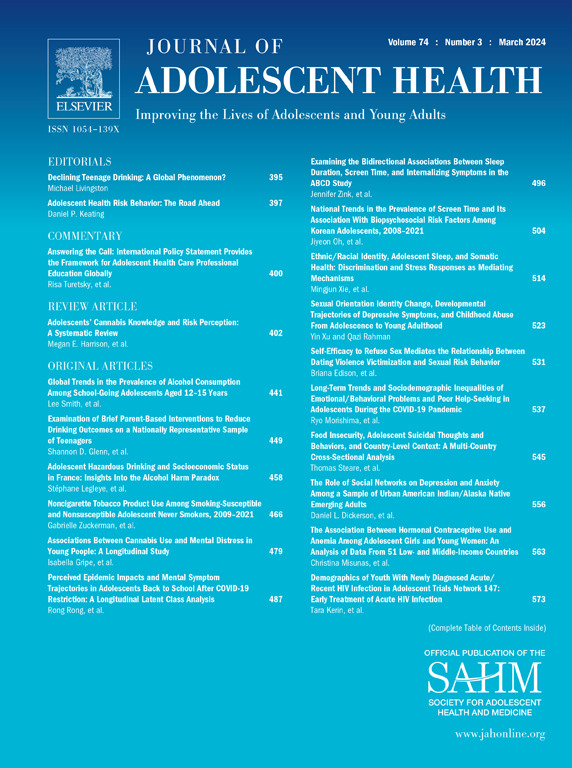评估临床医生在医疗保健过渡中的经验:来自六个医疗系统的结果。
IF 4.5
2区 医学
Q1 PEDIATRICS
引用次数: 0
摘要
目的:缺乏检验结构化医疗过渡(HCT)项目临床医生经验的证据。在HCT学习协作参与者中,本研究描述了临床医生实施结构化HCT过程的经验:获得了过渡的6个核心要素。方法:来自6个卫生系统的代表成员设计了一项调查,收集临床医生关于HCT和人口统计和实践信息的反馈。该调查包括改编的HCT活动第4级过渡评估和临床医生反馈调查,以及以下因素:临床角色、护理环境、状态、参与HCT过程实施的时间、倡导者的存在以及儿科和成人系统之间的伙伴关系。在2022年8月和9月期间,在儿科和成人临床环境中对参与HCT流程实施工作的855名临床医生进行了调查。进行统计分析以确定关键临床医师人口统计数据与调查反应之间的关系。结果:共有272名临床医生提供了关于实施结构化HCT流程的反馈(31%的回复率)。大约三分之二的患者报告了结构化HCT过程的保真度。大多数实现过程的6个核心元素包括转换策略、跟踪和转换计划。大多数临床医生认为,结构化的HCT流程可以提高安全性和护理质量,以及患者和临床医生的经验。在HCT过程中投入的时间与确保高层领导的支持显著相关。存在可识别的机构HCT流程改进冠军与积极的临床经验显着相关。讨论:临床医生发现,使用6个核心要素提供结构化的HCT流程并在其卫生系统中拥有一名倡导者具有积极的益处。他们承认需要在实践范围内的HCT过程中增加时间和持续投资。本文章由计算机程序翻译,如有差异,请以英文原文为准。
Evaluating Clinician Experience in Health Care Transition: Results From Six Health Systems
Purpose
There is a paucity of evidence examining clinician experiences with structured health-care transition (HCT) programs. Among HCT Learning Collaborative participants, this study describes clinician experiences with implementation of a structured HCT process: Got Transition’s 6 Core Elements.
Methods
Representative members from 6 health systems designed a survey to collect clinician feedback regarding HCT and demographic and practice information. The survey included adapted Got Transition Current Assessment of HCT Activities Level 4 and Clinician Feedback surveys as well as the following factors: clinical role, care setting, status, time involved in HCT process implementation, presence of champion, and partnership between pediatric and adult systems. Surveys were distributed across pediatric and adult clinical settings to 855 clinicians involved in HCT process implementation efforts during August and September 2022. Statistical analysis was performed to identify relationships between key clinician demographic data and responses on the survey.
Results
A total of 272 clinicians provided feedback (31% response rate) on implementing a structured HCT process. About two-thirds reported that fidelity to a structured HCT process was present. The 6 Core Elements most implemented processes included transition policy, tracking, and transition planning. The majority of clinicians agreed that a structured HCT process improves safety and quality of care, as well as both patient and clinician experiences. Time invested in HCT processes was significantly associated with securing senior leadership buy-in. Presence of an identifiable institutional HCT process improvement champion was significantly associated with positive clinician experiences.
Discussion
Clinicians found positive benefits in providing a structured HCT process using the 6 Core Elements and having a champion in their health system. They acknowledge that added time and continued investment in practice-wide HCT processes are needed.
求助全文
通过发布文献求助,成功后即可免费获取论文全文。
去求助
来源期刊

Journal of Adolescent Health
医学-公共卫生、环境卫生与职业卫生
CiteScore
10.40
自引率
3.90%
发文量
526
审稿时长
46 days
期刊介绍:
The Journal of Adolescent Health is a scientific publication dedicated to enhancing the health and well-being of adolescents and young adults. Our Journal covers a broad range of research topics, spanning from the basic biological and behavioral sciences to public health and policy. We welcome a variety of contributions, including original research papers, concise reports, literature reviews, clinical case reports, opinion pieces, and letters to the editor. We encourage professionals from diverse disciplines such as Anthropology, Education, Ethics, Global Health, Health Services Research, Law, Medicine, Mental and Behavioral Health, Nursing, Nutrition, Psychology, Public Health and Policy, Social Work, Sociology, and Youth Development to share their expertise and contribute to our mission of promoting adolescent health. Moreover, we value the voices of young individuals, family and community members, and healthcare professionals, and encourage them to submit poetry, personal narratives, images, and other creative works that provide unique insights into the experiences of adolescents and young adults. By combining scientific peer-reviewed research with creative expressions, our Journal aims to create a comprehensive understanding of the challenges and opportunities in adolescent and young adult health.
 求助内容:
求助内容: 应助结果提醒方式:
应助结果提醒方式:


